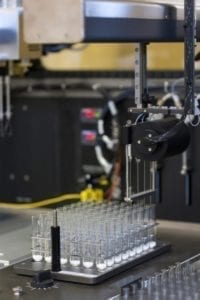
Sample preparation with a high-throughput robot in Clariant Catalysts’ expanded research center in Palo Alto, California. (Photo: Clariant)
Clariant Catalysts (Munich, Germany) is picking up speed with the successful expansion of its high-throughput R&D center in Palo Alto, California. Thanks to a significant investment, the upgraded facility is fitted with the latest high-throughput equipment, and will be home to an expanded team of technical experts. By doubling the research and development capacity of its Palo Alto facility, the company greatly strengthens its ability to offer faster and better solutions to its customers, and to support partners with custom catalyst scale-up projects.
High-throughput R&D combines state-of-the art hardware, robotics, automated procedures, and specialized software — including machine learning and other artificial intelligence (AI) tools — to enable up to 100 times faster experimentation compared to traditional practices. Clariant leverages this innovative methodology, along with its well-established expertise and knowledge in catalyst development and production, to accelerate time-to-market by reducing the catalyst discovery and development phase by 3–4 years.
commented, “The expansion of our Palo Alto high-throughput catalyst R&D center represents an essential milestone of our business strategy,” says Stefan Heuser, senior vice president & general manager at Clariant Catalysts. “Thanks to its location, the center capitalizes on the high-tech nature of Silicon Valley. We are very excited about the advances in catalyst technology we plan to achieve here for our customers.”
Since its establishment in 2009, Clariant’s Palo Alto center has focused exclusively on high- throughput catalyst research and development. Many of the scientists and engineers at the site have done pioneering work in this field, and tens of thousands of catalysts have been made and tested at the center. This has resulted in several highly successful commercial products, such as the selective hydrogenation catalyst OleMax 260.
Anthony Volpe, head of the Palo Alto R&D Center, describes the advantages of the expansion, stating, “Increasing our capacity allows us to boost both productivity and innovation, which will result in faster development of catalysts for our customers. We are also accelerating our work to advance the state-of-the-art in high throughput technologies, especially in supporting catalyst scale- up and production.”